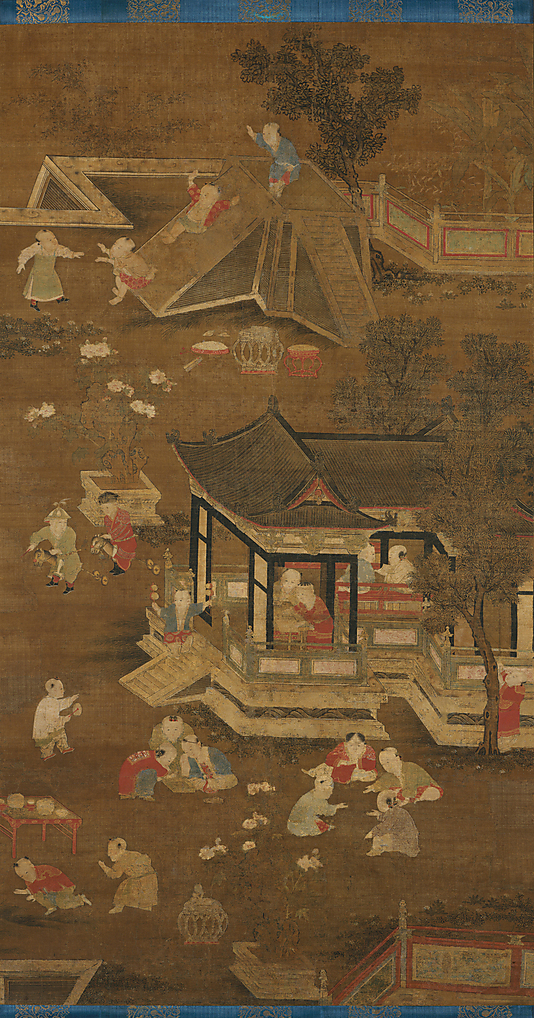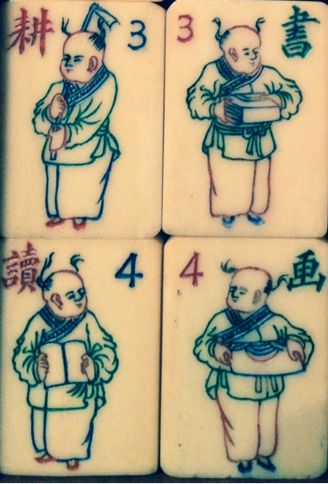This beautiful ink and color scroll on silk is from the collection of the Metropolitan Museum. Dating from the 13th century, it was done by an unknown artist. You can clearly see children everywhere, chasing each other, riding pretend horses, sliding down slides (who knew these things existed back then?)
Children are one of the most popular themes in Chinese art, and frequently can be seen playing in a garden, as above. According to Ann Barrow Wicks and Ellen B. Avril, in Children in Chinese Art, children have had a prominent place in art since the Song period which lasted from 960 until 1279. Images of children meant a lot to people all over China, to people of all classes.

These unusual hand-carved bone and bamboo Mahjong Flower tiles are from a lovely set of tiles.
Ray Heaton has translated the characters on these tiles for us:
"This set uses some fairly common words/phrases, but the images on the tiles are great aren't they!
Did you know there are two types of Chinese characters, Simplified and Traditional? The Simplified characters were "introduced" in the late 1950s and 1960s to help literacy in mainland China, although simple forms had been used for a long time before then, sometimes with local variation. I tend to use Traditional characters so sometimes the characters I use may look a little different to those on the tiles if I forget to note a difference! Much of this character simplification exercise from the 50s and 60s used the previously simplified forms or forms that were used in various handwritten scripts. Hong Kong and Taiwan still use traditional characters.
So, taking the green Chinese characters first (the right hand set)...
The tiles are The Four Arts or the Four Arts of the Chinese Scholar, and were the four main accomplishments required of the Chinese scholar gentleman.
They are;
qin (the guqin, a stringed instrument. Tile #1,琴),
qi (the strategy game of Go or Chinese Chess, ,Xiangqi', Tile#2, 棋),
shu ( Chinese calligraphy tile#3,書) and
hua (Chinese painting tile#4,畫).
The last two can be particularly difficult to work out as the Chinese characters are often simplified in rather novel ways, a kind of short hand, and they get transposed with each other too.
And the other four, the red Chinese character set, shows the Four Noble Professions:
Tile #1, 漁, Yu, Fisherman
#2, 樵, Qiao, to Gather Wood, an abbreviated way of saying Woodcutter
#3, 耕, Geng, to Plow
#4, 讀, Dou, to Read or to Study
So these represent Fisherman, Woodcutter, Farmer and Scholar.
(You may also see the Four Noble Professions described as scholar, farmer, artisans and merchants.)
You may notice some real differences in the Chinese characters I used here (traditional) with those on the tiles (simplified). For example, tile #1, Fisherman, shows a character closer to 渔, which is the simplified version of 漁.
The tiles again reflect the desire for sons to maintain the family line and to perform ancestral duties; during the Ming period this extended to the hope for Guizi, or Noble Sons, who would excel in their studies and take top honours in the civil service examinations, and so bring wealth and high honour to their families. So in the Ming period, boys began to be shown not just at play, but also showing 'clues' or symbolic references to wealth, fertility and distinguished success in officialdom. I think your tiles are, then, referring back to such desires."
The images of the scholars and the noble callings have been given more visual and emotional interest by the artist by using children to showcase these symbols. The Scholar tiles ring as true today as they must have years ago. Don't they sum up to us how parents everywhere want good things to happen for their children?
To learn more about Mahjong's art, you might like to consider this purchase:
The book I wrote with Ann Israel is being published by Tuttle. To see more about it:
www.mahjonggtheartof thegame.com
To order it click here:
http://www.barnesandnoble.com/w/mah-jongg-ann-israel/1118759459?ean=9784805313237
or here from Amazon
http://www.amazon.com/Mah-Jongg-Collectors-Guide-Tiles/dp/4805313234/ref=sr_1_7?ie=UTF8&qid=1414844427&sr=8-7&keywords=mah+jongg



Tony Watson
Isn't it strange that the the characterisation of the children in the 13thC Scroll is so much more realistic than any of the Western art from that period?
Having said that, the concept of perspective eluded the Chinese mind for centuries after the West discovered it, and we still see that lack of perspective in many of the elaborate flower tiles.
Attached is a pic of the flower tiles from a 'ladies' bone & bamboo set, showing children playing musical instruments. This set is quite unusual in that it has around 10 different colours, rather than the usual 3 or 4. The carving is also exceptionally fine - these sets are very underrated and can be picked up quite cheaply (and I've just shot myself in the foot!)